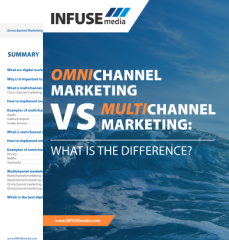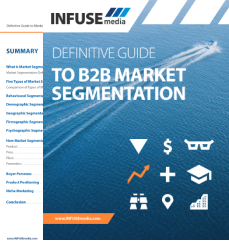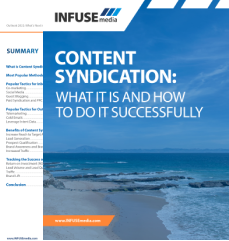Developing a channel marketing strategy that suits your brand, objectives, and target audience is a challenging task. As the B2B user experience continues to evolve, so must channel marketing.
What Are Great Channel Marketing Strategies?
What is channel marketing?
Channel marketing refers to the planning and development of strategies across each individual point of contact with prospective and existing clients. The channels chosen should vary depending on changing trends, the needs of prospects, and occasionally highly targeted campaigns. Strategies can be made up of a mix of digital or in-person marketing channels, as necessary for the goals of each campaign.
In some cases, channel marketing also refers to a partnership between a B2B company and a third-party reseller of their products. However, in this article, we are referring to the initial definition which covers the modern marketing options, or 'channels', that brands use to communicate directly with prospects (such as email, social media, events, etc.).

Why implement a channel marketing strategy?
Aligning marketing channels with specific functions or stages of the buyer journey helps to create a smoother experience for prospects. Developing a strategy allows marketers to create campaigns that reach specific market segments where they are active. Channels can later be evaluated and prioritised depending on their performance.
However, to reap the benefits of channel marketing it is crucial to carefully craft your plan to ensure accuracy and avoid wasting resources. This article explores the seven best practices for developing or enhancing a channel marketing strategy.
Digital vs. In-person channels
This starts with the decision to prioritise digital or in-person channels or a mix of both. Establishing this acts as a blueprint for your marketing channel goals.
Digital Channels
In-person Channels
Content marketing (publishing
on a proprietary or third-party website)
Events/ Conferences
Email Marketing
Exhibitions
Paid media (PPC)
Live demos
Programmatic display (Retargeting)
Meetings
Social media
Websites

In-person channels deliver a more personal experience with face-to-face interactions. However, in the face of complications with live events from the impact of the pandemic and their higher cost, digital channels are becoming more and more popular. Be sure to evaluate the benefits and drawbacks of digital vs. in-person channels in terms of your specific objectives before deciding.
Types of channel marketing
This is the process of publishing marketing materials across multiple channels to reach a wide range of audiences. However, in multi-channel marketing, channels are kept separate from each other, both in terms of progressing the buyer journey and the data they field. This means that the same message is broadcasted simultaneously across all channels, making this a business-centric strategy.
Cross-channel marketing:
This strategy is often regarded as the next step from multi-channel marketing, as it involves greater channel integration. Each channel compliments one another by facilitating the next step in the buyer journey. For example, in a cross-channel marketing strategy, signing up for an account on a website would be followed up on a second channel with a confirmation email.
In this strategy, all channels are interconnected with messaging informed by previous user behaviour. This personalisation creates a smoother buyer experience that aims to connect with prospects at the right cadence. Channels also share data and insights to fuel processes. As a result, this solution is often more expensive and time-consuming than others but is worth the investment for the client-centric experience it provides.
Field marketing:
Primarily an in-person channel strategy, field marketing features face-to-face activities focused on building brand image and stronger relationships with interaction. Whilst field marketing requires more time and budget to execute, the individual attention provided to prospects can create long-lasting value.
Making your decision:
Ultimately, the marketing channel strategy that you choose should be informed by knowledge of your target market, the goals of your marketing campaigns, and the resources available to you.
Deciding on the right type of channel marketing is a complex process that requires analysis of how each method can help you achieve your objectives.
Cut down on your research. Read our article, Omnichannel Marketing Vs. Multi-channel Marketing, for a detailed overview of both strategies, how to implement them, and how they can benefit your business.

Buyer personas act as the base of your strategy and help develop tactics for connecting with your target market across their preferred channels. Personas can also be used to establish which KPIs and metrics are important to track. These and any adjustments should be aligned with the sales process you have in place to ensure that your channel marketing boosts your sales strategies.
Market segmentation is crucial for determining key insights about your target market that can guide your channel marketing strategies.
Not sure how to get started? Read our Definitive Guide to B2B Market Segmentation for a full breakdown of segmentation techniques, their uses, and best practices.

Content marketing is not only a relatively affordable strategy but also allows marketers to adapt and repurpose their content
library as needed. This contributes to the long-lasting value that content marketing can provide.
Create a content distribution strategy
Crafting a variety of content is not enough to guarantee success as reaching your prospects often remains the greater challenge. Effective distribution is key for standing out in today’s competitive landscape.
There are several types of distribution that can implemented depending on the type of channel marketing strategy you are developing and your network:
Owned content distribution: This is the distribution of content on channels that you control, such as your proprietary website.
Earned content distribution: Channels owned by third parties share your content. This could be from guest posts, review sites, social platforms, syndication networks, or journalists.
Paid content distribution: This could include pay-per-click advertising, programmatic display, influencer, or affiliate marketing (see below for more detail), or sponsorships.
As each distribution method comes with its own benefits and drawbacks, it is often beneficial to implement a combination of all three types when possible. Essentially, the more relevant channels you can distribute your content on, the better.
Be sure that before establishing distribution with a partner, paid or otherwise, to set up guidelines. This avoids any misconceptions and keeps the goal of a partnership clear for both parties.
Develop your website as your channel hub
Regardless of how far you expand your content distribution and marketing channel strategy, the end goal of each channel is to bring traffic to your website. This makes your proprietary website your channel hub and therefore, your most important channel.
Take the time to develop a user experience that encourages visitors to stay on your site for longer and consume more content. This benefits the nurturing process and encourages prospects to convert by demonstrating industry expertise and the value they stand to receive by becoming clients. The better the internal linking between content on your site and product pages, the greater the utility of your content.
Creating a library of content that positions your organisation as an industry leader and allows you to connect with your audience requires a solid content plan and adaptive strategy.
Get started on developing high-quality, impactful content marketing by reading our Definitive Guide to B2B Content Marketing.

Repurpose content for different channels: Make the most out of your content’s potential by repurposing existing content into new formats that suit your audiences. Long-form content such as whitepapers, case studies, and eBooks can be edited into smaller, bite-sized formats.
Depending on the channel, this could include infographics, articles, or short videos. Not only is this budget-friendly but it also takes relatively little time and boosts your channel marketing by taking advantage of your content’s versatility.
Increase personalization: The more personalized your content, the more successful it will be. As prospects come to expect higher levels of personalization, adding specificity to your content is a great way to encourage engagement.

Co-marketing:
This is an agreement with a non-competitor to collaborate on content creation and share in the success, such as leads generated. Working with a partner with a suitable audience and sharing backlinks effectively adds another channel to your strategy. Boosting your reach this way can take relatively little time and depending on how established your partner is in their space, can also add to your standing and credibility.
However, be sure to thoroughly vet potential partnerships and set agreements to ensure both sides of the deal are maintained, and your brand image is not damaged by negative association.
Read our article, B2B Content Syndication: Popular Tactics and Metrics for Success, to learn more about co-marketing content distribution strategies.
Influencer marketing:
Social media platforms are an essential digital channel and should be a priority. Partnering with influencers can be an effective solution for reaching your audience where they are. Each influencer will bring different benefits to your strategy depending on their audience.
This not only includes the relevancy of their audience for your brand but also the size of their following. Whilst influencers with a larger presence are a popular choice, micro-influencers with a smaller, close-knit niche audience may deliver better results.
Affiliate marketing:
Promoting with affiliates is another example of how partnerships can benefit your channel marketing. Although the legitimacy of affiliate marketing is often questioned in B2B, it is entirely possible to implement. However, there are a few important best practices to consider.
After assessing each affiliate’s ability to promote your services to your target segment, be sure to develop strong incentives to motivate your affiliates. It is also important to share a detailed overview of your sales process, particularly for affiliates used to the shorter B2C sales cycle.
Referral marketing:
Easily confused with affiliate marketing, referral marketing leverages your own clients as advocates rather than an outsider. As a commonly untapped revenue stream, incentivising the sharing of positive client experiences with others in your target market is a great way to add credibility to your channel marketing.
The key to this strategy is giving your clients the means of sharing their experience and investing in exceptional client service. Increase your chances of success by backing up your referrals with an attractive marketing campaign that acts as a hook for any referred prospects.
Finding the right partner can be an arduous process. Fast-track your search by reading our article, Content Syndication: Finding the Best Networks and Strategy for You and Your Company.
Analyse their strategies and assess what makes them successful on each marketing channel. The aim here is not to copy your competitors but rather to take learnings from their strategies to kickstart your own.
Ensure that any tactics you develop from competitor analysis are aligned with your specific target audience and their preferences.
A/B testing
Regular testing is an efficient way to collect valuable data and drive the search for the most optimal marketing channel strategies for your target audience. As campaigns are developed and launched, it can be extremely beneficial to test more than one version to identify which resonates with target markets the most. This could include campaign elements such as landing pages, paid advertisements, or email marketing.
Data collected from testing can then be used to fuel adjustments and the development of future strategies, including which marketing channels to prioritise.

As the hub of your channel marketing strategy, your website should always take priority for optimisation. Make regular updates to content and analyze site performance to determine necessary changes to your site design. This could include layout and improving user experience (UX).
Consider developing and integrating more interactive features into your website such as video. This has the potential to increase clicks and the time each visitor spends on your page which could lead to higher conversion rates.
However, all new features and changes to your site should be supported by data from other channels and knowledge of your target audience’s preferences. Remember, your website is responsible for establishing and securing positive first impressions of your brand.
Leverage automation platforms
Given the number of digital channels and their individual needs, managing multi or omnichannel marketing strategies requires detailed planning and organisation. To combat this challenge and avoid valuable channels becoming neglected, it can be beneficial to adopt automation platforms.
These assist the optimisation of each campaign feature across your marketing channels by facilitating the scheduling of publications and maintenance. Automation platforms can also help campaign development by collecting data on the performance of each channel. Each platform has its own strengths and can even be used for lead scoring, nurturing, and ROI projections.
Align sales and marketing teams
Amongst many, one of the benefits of alignment, is how it serves to facilitate channel marketing strategies. Campaigns built from the beginning with a unified vision allow for marketers to integrate and learn from valuable insights supplied by the sales team. Sharing information across both teams helps for strategies to go beyond theory and accurately target prospects on the channels they actually use.
When campaigns go live, sales teams can also provide feedback based on interactions with prospects and how each channel performs in terms of sales enablement. All of this data results in a more refined approach that prioritises the most important marketing channels.
Aligning teams is crucial for ensuring consistent results. For more detail on the benefits of alignment and how to get started, read our full article: 10 Best Practices for Sales and Marketing Alignment.

Conclusion
Creating a successful marketing channel strategy is crucial to ensuring the success of demand generation and lead generation campaigns. Whilst this can seem like an arduous task, investing time in the individual facets of channel marketing can facilitate this process and deliver outstanding results.
INFUSE’s team of demand generation experts has helped clients with thousands of funnels that generated unmatched engagement. With a myriad of lead generation and demand generation tools at our disposal, we work with you to get you the results you are looking for.
Let’s build successful strategies for your business together.
Get in touch with the team at [email protected]










